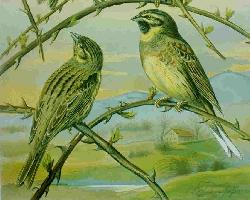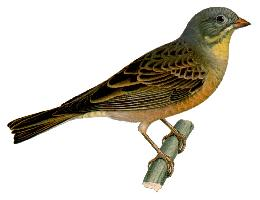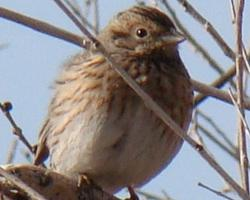
Description de l'animal
The Cirl Bunting (Emberiza cirlus) is a small, yet strikingly colorful passerine bird that belongs to the bunting family, Emberizidae. It is a species that has captivated birdwatchers and nature enthusiasts alike with its vivid plumage and melodic song. The Cirl Bunting is predominantly found across parts of Europe and the Mediterranean, favoring a habitat that offers a mix of open countryside with scattered bushes, trees, and areas of cultivation, which provide both feeding opportunities and nesting sites.Adult Cirl Buntings are small birds, measuring about 15-16.5 cm in length, with a wingspan ranging from 21 to 25.5 cm. They exhibit sexual dimorphism, meaning males and females can be distinguished by differences in their plumage. The male Cirl Bunting is particularly eye-catching during the breeding season with its bright yellow underparts contrasted by a distinct black face mask that extends through the eye area, a rich chestnut back, and greenish shoulders. The wings are dark with bright yellow and green flashes, which become visible in flight or when the bird is displaying. The female, in contrast, is more subdued in color, with duller yellow underparts and a more uniform brownish appearance on the back and wings, which helps her remain inconspicuous, especially during the nesting period.
Cirl Buntings are granivorous, feeding mainly on seeds of grasses and cereals, though their diet also includes insects, especially during the breeding season, when they need additional protein for egg production and feeding their young. They forage on the ground, among low vegetation, where their food sources are most abundant.
Breeding usually takes place from late April to August. The Cirl Bunting is monogamous, with pairs forming strong bonds throughout the breeding season. The female is responsible for constructing the nest, which is typically placed in a low bush or on the ground, hidden among dense vegetation. It is made of grass, roots, and leaves, lined with finer materials for the comfort of the eggs and chicks. The clutch consists of 3 to 5 eggs, which are incubated primarily by the female for about 12 to 14 days. Both parents are involved in feeding the chicks, which fledge approximately two weeks after hatching.
One of the most delightful aspects of the Cirl Bunting is its song. The male's song is a cheerful, repetitive series of clear, melodious notes, often delivered from a prominent perch. This song plays a crucial role in territorial defense and in attracting a mate.
Despite its beauty and charm, the Cirl Bunting has faced significant threats in parts of its range, primarily due to changes in agricultural practices that have led to the loss of its preferred habitat. Efforts to conserve the species have been implemented in several regions, focusing on preserving and restoring suitable habitats.
In summary, the Cirl Bunting is a small, yet beautifully adorned bird, with a lifestyle and behaviors that reflect its adaptation to the open, mixed landscapes of Europe and the Mediterranean. Its presence adds a splash of color and a melody to the countryside, making it a cherished species among bird enthusiasts and conservationists.
Animaux similaires
Nouvelles photos d'animaux
Top 10 des animaux
- Dolphin gull (Leucophaeus scoresbii)
- Diana monkey (Cercopithecus diana)
- Moustached guenon (Cercopithecus cephus)
- Galápagos tortoise (Geochelone nigra complex)
- Russian tortoise (Testudo horsfieldii)
- Japanese macaque (Macaca fuscata)
- Stone loach (Barbatula barbatula)
- Greek tortoise (Testudo graeca)
- Common flying dragon (Draco volans)
- Colossal squid (Mesonychoteuthis hamiltoni)


